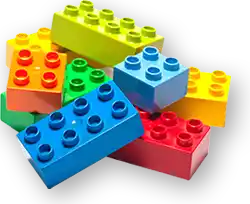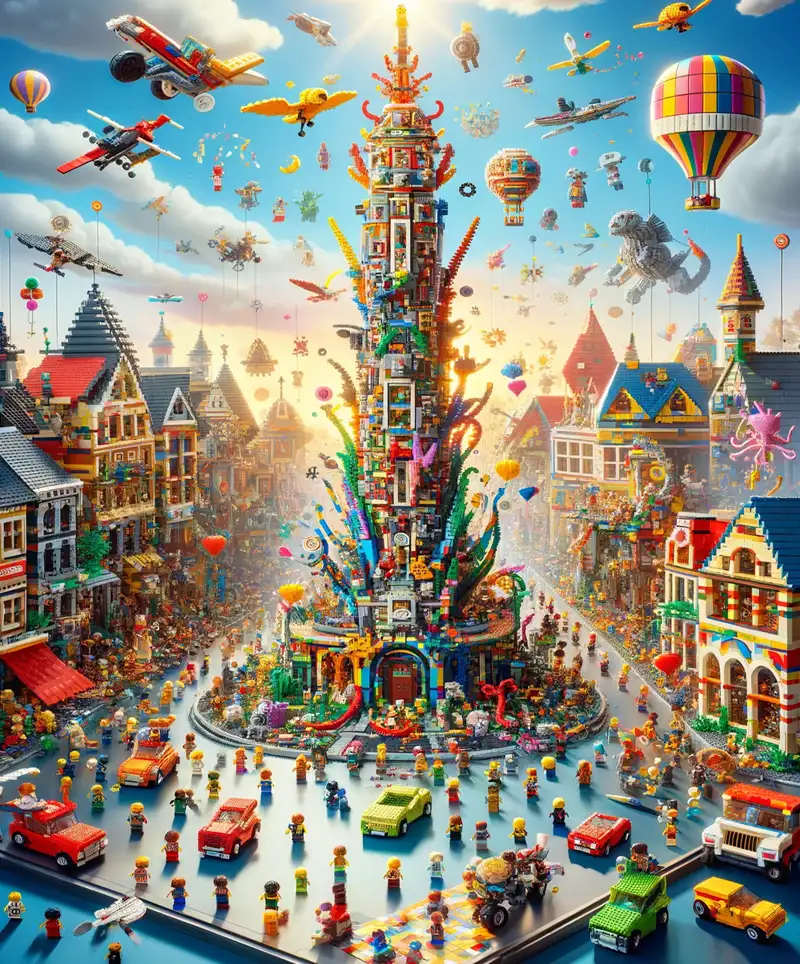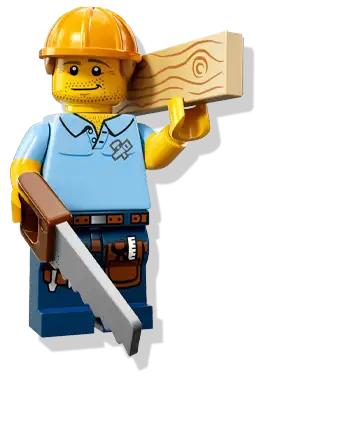Building Blocks of Fun and Creativity
Every January 28th, the world comes together to celebrate International Lego Day, marking the momentous day in 1958 when the patent for the original Lego brick was filed. It’s not just a day; it's a festival of snapping plastic, colorful chaos, and the sweet nostalgia of childhood. This day is less about commemorating a piece of Danish patent history and more about honoring the joyous clinks, clacks, and occasional cries of "Ouch!" as yet another adult steps on a rogue brick barefoot. International Lego Day is the day we celebrate those tiny, ingenious bricks that have the power to transform a boring Sunday into an epic saga of construction, deconstruction, and reconstruction, all before lunchtime. It's a tribute to the blocks that have built worlds in living rooms and have the uncanny ability to disappear into thin air, only to be found by unsuspecting feet at 2 AM. So, grab your baseplates and prepare your fingertips for a day of endless possibilities and the inevitable search for that one piece that seems to have vanished into the Lego void!
The Humble Beginnings
 Let's turn back the pages of history to a quaint Danish village post-World War II. Here, in Billund, we find the birthplace of Lego, a story that begins not with a click of plastic but with a chisel of wood. Ole Kirk Christiansen, a humble carpenter with a vision, started creating wooden toys in a small workshop. His ethos, “Only the best is good enough,” wasn't just a catchy slogan; it was a philosophy that would lay the foundation for a global phenomenon.
Let's turn back the pages of history to a quaint Danish village post-World War II. Here, in Billund, we find the birthplace of Lego, a story that begins not with a click of plastic but with a chisel of wood. Ole Kirk Christiansen, a humble carpenter with a vision, started creating wooden toys in a small workshop. His ethos, “Only the best is good enough,” wasn't just a catchy slogan; it was a philosophy that would lay the foundation for a global phenomenon.
In the early years, Christiansen's toys were simple, yet they captured the hearts of Danish children. His company, named 'Lego' from the Danish phrase “leg godt” meaning “play well,” began to gain local fame. The Lego story could have remained just that, a local success story, but destiny had other plans. In 1947, Lego became one of the first companies in Denmark to purchase a plastic injection molding machine. This machine, initially bought to make plastic household items, soon became the birth-giver to the Lego brick we know today.
It was in 1958, a year that would forever be etched in the annals of toy history when the modern Lego brick was patented. The brick's design, a masterpiece of engineering, featured tubes inside that allowed for a tighter, more versatile grip. This meant that these bricks could be stacked in all sorts of ways, sparking endless creativity. It was a revolutionary moment, not just for the Lego Group but for playrooms around the world.
This was the turning point. From those early wooden toys, Lego had transitioned into the world of colorful plastic bricks. But these weren't just toys; they were the building blocks of imagination, the raw materials for creativity. The humble beginnings of Lego in a small Danish workshop were now set to become a story told in millions of homes across the globe, a testament to the power of a simple idea executed brilliantly.
As children and adults alike began to snap those bricks together, building everything from castles to spaceships, a new form of play was born. One that wasn't about following instructions (though that came later), but about creating something new, something unique, something that came straight from the wildest corners of the imagination.
The legacy of those early days is still seen in every Lego brick made today. Each piece holds within it the spirit of innovation, quality, and joy that Ole Kirk Christiansen envisioned in his small workshop. It's a reminder that sometimes the simplest of ideas can build a world of endless possibilities.
The Rise of a Cultural Icon
From a simple brick, a vast universe was built. The Lego Group expanded its repertoire, bringing in themed sets, mini-figures, and even sophisticated robotic lines. Remember the thrill of building your first Lego castle? Or the agony of stepping on a stray brick? That's the universal Lego experience - a mix of joy, creativity, and occasional foot pain.
Lego transcends age barriers. It's not just a child's toy; it's an architect's model, a designer's prototype, and even a filmmaker's medium. The versatility of Lego bricks has led to some astonishing creations - from life-size sculptures to functioning machines. Did you know there's even a functional Lego car powered by air? That's right, creativity knows no bounds in the Lego universe!
Lego's contribution to education is noteworthy. The brand's focus on STEM learning through its Technic and Mindstorms lines has introduced kids to the basics of engineering, robotics, and computer programming. These colorful bricks are shaping future innovators and problem-solvers, one click at a time.
International Lego Day isn't just about individual creativity; it's a celebration of community. Across the globe, adult fans of Lego (AFOLs) gather to share their creations, exchange ideas, and engage in building competitions. These gatherings highlight the unifying power of Lego, bringing together people of all ages and backgrounds.
Lego in Pop Culture
Lego's influence on pop culture is undeniable. From "The Lego Movie" with its catchy “Everything is Awesome” tune to the numerous video games, TV shows, and theme parks, Lego has created an entertainment empire. Who knew a tiny plastic brick could lead to such big-screen fame?
 In recent years, Lego has pledged to make a significant environmental shift. By 2030, the company aims to produce all its bricks from sustainable materials, reducing the plastic footprint and ensuring that the joy of Lego continues for future generations without harming the planet.
In recent years, Lego has pledged to make a significant environmental shift. By 2030, the company aims to produce all its bricks from sustainable materials, reducing the plastic footprint and ensuring that the joy of Lego continues for future generations without harming the planet.
International Lego Day is more than just a celebration of the iconic brick; it's a nod to the power of imagination. It reminds us that with a handful of Lego bricks, the possibilities are limitless. Whether you're a professional builder, a casual enthusiast, or someone who fondly remembers the clatter of bricks from childhood, this day is for you. So, on January 28th, let’s unleash our creativity brick by brick!
Please Share our Content






 Let's turn back the pages of history to a quaint Danish village post-World War II. Here, in Billund, we find the birthplace of Lego, a story that begins not with a click of plastic but with a chisel of wood. Ole Kirk Christiansen, a humble carpenter with a vision, started creating wooden toys in a small workshop. His ethos, “Only the best is good enough,” wasn't just a catchy slogan; it was a philosophy that would lay the foundation for a global phenomenon.
Let's turn back the pages of history to a quaint Danish village post-World War II. Here, in Billund, we find the birthplace of Lego, a story that begins not with a click of plastic but with a chisel of wood. Ole Kirk Christiansen, a humble carpenter with a vision, started creating wooden toys in a small workshop. His ethos, “Only the best is good enough,” wasn't just a catchy slogan; it was a philosophy that would lay the foundation for a global phenomenon. In recent years, Lego has pledged to make a significant environmental shift. By 2030, the company aims to produce all its bricks from sustainable materials, reducing the plastic footprint and ensuring that the joy of Lego continues for future generations without harming the planet.
In recent years, Lego has pledged to make a significant environmental shift. By 2030, the company aims to produce all its bricks from sustainable materials, reducing the plastic footprint and ensuring that the joy of Lego continues for future generations without harming the planet.








 "Sláinte!" is a traditional Irish expression used as a toast, equivalent to "Cheers!" in English.
"Sláinte!" is a traditional Irish expression used as a toast, equivalent to "Cheers!" in English.